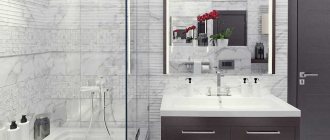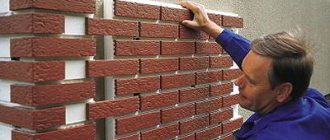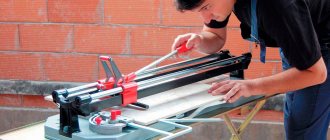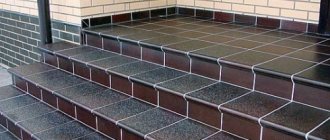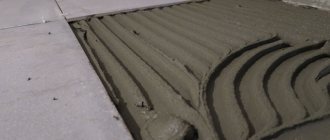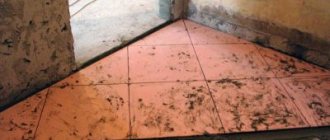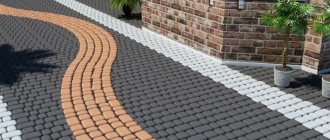No. 1. What is ceiling polystyrene foam?
Decorative tiles are made from polystyrene, which foams when heated. During production, fire retardants and carbon dioxide , substances that increase resistance to high temperatures. Expanded polystyrene tiles made in this way, although they melt under the influence of fire, still perform better than ordinary polystyrene foam. By the way, you can also find foam ceiling tiles on sale: they are not only less safe, but also rougher in appearance. The presence of fire retardants in the composition of the boards is indicated by the marking : domestic manufacturers add the letter C, foreign manufacturers – F.
The material may vary greatly in size, shape, color and appearance. On sale you can find tiles in square, rectangular and designer shapes. The surface can imitate decorative plaster in a country style or exquisite stucco in the Baroque style. The classic color of the tile is white, but colored versions and products with a mirror and laminated surface are also sold. Standard sizes are 50*50 and 100*16.5 cm, but other formats are also available.
Advantages and disadvantages of ceiling panels
One of the types of foam ceiling cladding is rectangular slabs. As a type of facing materials, ceiling panels have their advantages and disadvantages.
Among the advantages of this material are the following:
- lightness of the material, making it easier to transport, store and install the cladding;
- presence of fire-fighting properties;
- resistance of the material to chemicals based on alcohol, acid, alkali, lime, cement and gypsum;
- environmental friendliness of ceiling panels;
- protection against rotting;
- Sheathing resistance to high temperatures and mold;
- endurance of high humidity, provided there is a ventilation system;
- affordable pricing policy.
The above-mentioned advantages of ceiling panels should be supplemented by the fact that there is no need for special care. This lining can be cleaned using a vacuum cleaner. If the room has laminated cladding, you can refresh the tiles using a cloth moistened with soapy water.
The main disadvantages of foam ceiling panels initially include the fact that they will not be appropriate in all interiors.
For example, despite the constantly developing and updated range, it is very difficult to find tiles that would organically fit into the high-tech style.
Also, this type of cladding can complicate the process of painting the ceiling. Products containing organic solvents often deform foam ceiling cladding.
No. 2. Advantages and disadvantages
Expanded polystyrene ceiling tiles are among the most popular finishing materials. Buyers appreciate it for its numerous advantages :
- affordable price . In this regard, tiles can become a competitor even to ordinary painting. The most expensive samples with an exquisite design, which do not allow you to determine at first glance what the ceiling is made of, will cost much less than, for example, a system of suspended or suspended ceilings;
- ease of installation . You can cope with gluing ceiling tiles on your own, without any special skills. Considering the low price of the material, it can be called an ideal choice if the budget for repairs is limited;
- big variety . On sale you can find both the simplest white tiles with a simple pattern, and materials that very accurately replicate the structure of wood or stone, so you can use ceiling tiles to decorate any interior. White tiles can be painted in any desired shade;
- additional heat and sound insulation premises;
- resistance to temperature changes and high humidity, so the tiles can even be used in the bathroom;
- tiles do not steal height, unlike stretch and suspended ceilings. Additionally, it hides small irregularities and cracks that would definitely have to be removed when painting;
- expanded polystyrene - although an unnatural material, it does not pose any particular danger. It does not emit harmful substances under normal operating conditions, unless, of course, it is made with high quality and has all safety certificates. Tiles become dangerous at high temperatures, i.e. during a fire;
- The material is easy to care for; it can be cleaned with a vacuum cleaner or a damp sponge;
- high maintainability. If part of the ceiling is damaged, then several old elements can easily be replaced with new ones, so always take tiles with a reserve.
Now about the disadvantages :
- low durability and the ability to turn yellow over time, and the process accelerates if direct sunlight constantly falls on the surface;
- tiles are easily damaged by tobacco smoke, grease and soot, so they are not recommended for use in the kitchen;
- constant temperature changes can lead to some elements falling off, but this is only if low-quality glue was chosen for installation;
- expanded polystyrene is a fairly delicate material, so you should be careful when transporting and installing it;
- expanded polystyrene tiles are not very resistant to fire, and even when impregnated with fire retardants, they can ignite, releasing toxic substances. To be on the safe side, it is better not to place the lamp very close to the ceiling. Such precautions will also prevent yellow spots from the lamp from appearing on the material;
- When cleaning the surface, you should be extremely careful - a too wet sponge or using a rough brush can cause the tiles to peel off.
Experts convince us that truly high-quality ceiling tiles, thanks to the additives used, do not turn yellow for a long time and almost do not support combustion. Conscientious manufacturers declare that all the myths that exist among people are caused by the abundance of low-quality products on the shelf, and they advise you to always ask for a certificate of conformity. Sometimes we ourselves are to blame for the fact that the experience of using polystyrene foam turns out to be negative. It’s not just about choosing low-quality tiles, but also about choosing the wrong adhesive, on which a lot also depends.
Expanded polystyrene ceiling tiles can be used in almost any room. It is undesirable to just glue it in the kitchen, and you can still find other material for the nursery.
The difference between seamless ceiling tiles and regular ones
Unlike regular tiles, which have a bevel, seamless panels are made in such a way that the edges remain smooth, in the same plane as the entire surface. After installation, the seams become invisible. Thanks to this difference, the finish looks like a single canvas, and not separate parts, as is the case with joint tiles.
The surface is covered with patterns and ornaments, which after gluing form a single pattern. For small rooms such as a kitchen, bathroom or balcony, it is better to use a small pattern. A large ornament will look good in a spacious room.
Seamless ceiling tiles are available in the same sizes, most often 50x50 cm. There are two options in shape. The square one is made with perfectly smooth (calibrated) edges. The tiles fit together with a minimal gap, which is only noticeable if you look closely.
Elements of complex shapes, with wavy or zigzag edges, are also available. It is almost impossible to see the seams on the finished ceiling, since they are not located in a straight line. But such tiles are more difficult to lay.
Based on the production method and properties, the coating is divided into three types:
- Pressed . The most budget-friendly, it is made from foam plastic in molds with patterns in the form of textures and patterns. Graininess is noticeable on the surface, and there may be defects (chips, unevenness, etc.). Pressed seamless ceiling tiles are more fragile than other varieties, absorb moisture and absorb dust. Thickness about 5 mm.
- Injection . Produced from expanded polystyrene by sintering under high temperature. The surface is defect-free, and the panels themselves are stronger and thicker (up to 15 mm). Therefore, you can make a deep relief that creates a voluminous effect.
- Extruded . The thinnest ceiling tile without seams (3-5 mm) and at the same time durable. Polystyrene granules and various additives are sintered under pressure and then covered with a film for protection. The panel has a smooth surface, the pattern on which imitates wood, stone or other materials. The cost is higher than other types.
A seamless ceiling made of tiles of all types has a common advantage - the finish looks like a single whole, and not separate elements. This makes the room seem more spacious.
Important! The ceiling under seamless tiles will have to be leveled more carefully than under ordinary tiles. Differences in height of no more than 2-5 mm are permissible, otherwise you will not get invisible joints.
No. 3. Main types of polystyrene foam tiles
According to the type of production, ceiling polystyrene foam can be of the following types:
- stamped or pressed;
- extruded;
- injection.
Stamped boards are produced by placing polystyrene foam blocks into special molds and then compressing them. The result is products with the simplest and not very relief patterns, small thickness (about 6-8 mm) and very fragile. Since such slabs are not covered with a protective layer, they absorb dirt well and are difficult to clean. The main advantage is the price.
Extruded panels are considered the most durable, durable, reliable and moisture resistant. The material is produced by hot extrusion of strips of raw materials. The result is tiles with a slight grain size and an almost smooth, dense surface, making it possible to apply a decorative coating. Such panels can be simply white and have complex patterns, or they can imitate the surface of any type of wood or stone. Due to high density, minimal porosity and impregnation with water-repellent compounds, the material obtains sufficient resistance to moisture. It is extruded tiles that can be seamless, which we will discuss below.
Injection polystyrene foam is produced by filling raw materials into a mold and sintering it under high temperatures. The result is a product with precise geometry and a clear relief pattern, the thickness of the slabs is 9-14 mm. Such panels tolerate moisture well, retain noise and heat well, are quite durable and come in a wide variety of patterns. Due to their intricate ornamentation and good performance qualities, such slabs are sometimes even used for wall decoration. Often injection panels are produced with imitation leather, wood, fabric, and ceramics.
Types of ceiling tiles without seams
Seamless tiles are made from polymer materials and in terms of user qualities they are not much different from ordinary ones. Its peculiarity lies in its production technology. The edges of such a product are slightly curved so that when laying the seams between them are not visible.
The back side of the tile is smooth, which makes it easier to attach to the surface. The front is embossed with a relief pattern of varying complexity, although there are also smooth models. It is worth noting that the ornament also contributes to the formation of a uniform surface, as it distracts attention from the seams.
Classification by manufacturing technology
Plastic finishing is produced in several ways. Depending on the manufacturing technology, the properties of the product change:
- pressed - the most affordable, the material is fed to a stamping press, where it takes the appropriate shape - with a smooth or embossed surface, the thickness of the product does not exceed 5 mm, the mechanical strength is low;
- injection - plastic is sintered in special molds and it acquires high strength, the thickness of the product varies from 8 to 15 mm, this allows the formation of a complex texture and pattern;
- extrusion - during production, foaming compounds are added to the polymer mass, and then the blanks are formed under the influence of high temperature; a protective film is applied to the strips, which also performs an aesthetic function: it imitates metal, wood, stone with high precision; The thickness of the product is no more than 5 mm, but its strength is very high.
Extruded ceiling tiles are the most expensive. However, it is durable and provides a huge selection of patterns and textures.
Classification by shape
Classic tiles are rectangular or square. Modern technologies make it possible to obtain more interesting seamless plastic tiles for ceiling decoration:
- panels with curly edges - the ends of the tiles have a complex shape: wavy, zigzag, with recesses of a different configuration, it is these “irregularities” that provide a stronger and tighter joint, the seams are invisible even at a short distance;
- option with calibrated edges - the perfectly precise geometry of the product creates an even, seamless ceiling, even using completely smooth tiles;
- ceiling panel with decorative filling - this is the name given to models with a catchy and very embossed decorative pattern, most often these are injection tiles, in which the thickness allows you to reproduce stucco.
The complex shape not only masks the seams, but also hides some defects of the uneven surface.
No. 4. Surface type
In terms of variety, polystyrene foam ceiling tiles outshine many other finishing materials. Based on surface type, the entire range presented can be divided into the following types:
- ordinary white tiles , which, if desired, can be painted in any suitable shade;
- plain colored tiles;
- laminated tiles. Due to the thin film that is applied on top of polystyrene foam, you can imitate any type of wood, stone and other noble materials. The film allows you to make the tiles more resistant to moisture and dirt, as well as simplify the process of cleaning them;
- Mirror tiles are distinguished by the presence of a thin mirror layer. Such products are exclusive design options and are great for decorating small spaces, as they will visually expand the space. The only exception is the bedroom, where a mirrored ceiling is inappropriate.
The shape of the tile can be square, rectangular, diamond-shaped, there are also irregular tiles, the so-called. designer form.
How to glue foam ceiling tiles: instructions
When the task is to repair the ceiling cheaply, with little labor and beautifully, foam ceiling tiles can be a good solution. They are not very demanding on the surface that needs to be covered, they are lightweight, and they have the property of absorbing sound. Tile manufacturers will delight you with a wide range. You will be able to play with the design, choose the most suitable ones for the room: type, color, pattern, thickness of the ceiling tiles.
Types of foam ceiling tiles
Types and characteristics of foam ceiling tiles
Firstly, types of foam tiles can vary in shape:
- square, with a side length of 50 cm - such tiles are most common;
- rectangular, in the form of panels - used much less frequently, as a rule, for finishing in non-residential public premises;
- diamond-shaped;
- hexagonal.
In the photo: decorative foam tiles on the ceiling
Secondly, according to the manufacturing method:
- pressed or stamped - such tiles are obtained by compacting foam plastic boards with an industrial press. Their thickness is on average 7-8 mm;
- injection - cast in molds using high-temperature conditions. This method produces thicker foam tiles (up to 14 mm);
- extruded. In the production of tiles of this type, decorative film (2.5-3 mm) can be used.
Also, tiles can vary in color and texture (smooth, embossed). Can be laminated or plain.
Foam ceiling tiles are also characterized by their positive and negative properties.
The advantages include:
- heat and sound insulation
- moisture resistance
- resistance to fungi and mold
- not susceptible to rotting
- low price.
Tiles can hide small imperfections on the surface. To stick it on you don’t need any special skills or special tools.
Among the disadvantages, it is worth mentioning, first of all, the fire hazard.
Foam ceiling tiles do not like direct sunlight. With prolonged exposure, the foam turns yellow and loses strength. A large number of joints can also be attributed to the disadvantages of the tiles, since the feeling of integrity of the ceiling surface is lost. The exception is seamless tiles.
Seamless foam ceiling tiles Thanks to this type of tile, you can get a smooth monolithic ceiling. Joint seams are masked due to the special shape of the edges of the tiles. Such tiles are made by pressing (stamping). The size is usually 50x50cm. White color. The foam in these tiles is very soft, which allows you to tightly connect the tiles to each other and make the joint almost invisible. Seamless foam tiles have their own installation technology. It is recommended to use quick-drying glue.
Foam ceiling tile dimensions
Ceiling tiles 50x50 made of foam plastic
- The standard dimensions for square tiles are 50x50 cm; small tiles are found - 30x30 cm.
- Rectangular tiles are made 100x16.5 cm.
- The thickness of foam ceiling tiles, as noted above, can vary from 2.5 to 14 mm.
How to glue foam ceiling tiles
To tile your ceiling with foam plastic tiles yourself, you should use the instructions for its installation, where all its stages will be explained step by step.
Installation instructions for foam ceiling tiles
- Preparatory stage. This includes cleaning the ceiling from old coatings, leveling strong differences and priming the ceiling surface. You also need to prepare the following tools: a sharp knife (stationery knife), a ruler, a tape measure, a hammer, a pencil and a clean rag. It is important to choose the right glue.
Through the center, using a paint cord, you should beat off two perpendicular lines along which the first tiles will be aligned. The first tiles meet at the corners in the center of the marking; corners are cut off near the chandelier cord, which will then be covered with its glass. Next, the foam tiles are glued in a spiral around the center. It is important to ensure that the rows run parallel to each other, preventing the tiles from moving. At the junction with the walls, the tiles are cut to size with a knife before applying glue to them, so that it is possible to try on and correct the cut. As a rule, a small gap is allowed near the wall, which is then hidden by the ceiling plinth.
Finishing the ceiling with foam tiles, as we have seen, is a convenient, not complicated and quite budget option. Additional decor in the form of a rosette for a chandelier and a ceiling plinth will give the ceiling a complete look.
A little trick. You can apply staining to prevent yellowing of the tiles and to additionally disguise the joining seams.
Painting foam ceiling tiles
Not all types of ceiling tiles can be painted. For example, laminated tiles are unlikely to be suitable for this purpose. It is worth painting with acrylic paint or water-based paint.
The paint can be easily tinted to any shade. When choosing a paint, it is important to take into account such indicators as dullness (glossy), hiding power, consumption, and the presence of antiseptic additives.
The process of painting foam tiles on the ceiling
It is better to paint with a roller from the window, using movements perpendicular to the window line. In corners, joints, ceiling plinths and rosettes, as well as problematic and unpainted areas, go over with a brush. To prevent dripping from the baseboard onto the wall, it is better to stick masking tape along all the baseboards while painting along the top of the wall.
Foam ceiling tile price
Depending on the type of foam ceiling tiles, prices may vary. From 10 rubles/piece for the simplest white non-laminated tiles to 150 rubles/piece (seamless tiles)
Where to buy foam ceiling tiles?
You can purchase ceiling tiles in large hypermarkets of building and finishing materials, in construction markets or in online stores.
- KUBIK, repair goods store: Moscow, Fergana proezd, 10A building 3;
- Online store kubikstroy.ru: Moscow, Novocherkassky Boulevard, 13.
- Leroy Merlin chain of hypermarkets for home and garden goods: Moscow, st. Verkhnyaya Krasnoselskaya, ow. 3a, Troika shopping center;
- Leroy Merlin chain of hypermarkets for home and garden goods: St. Petersburg, st. Kollontai, 3;
- Construction hypermarket "MOYDOM" St. Petersburg, Kolpino: St. Oktyabrskaya, 8, shopping center "OKA".
- "Stroitel" chain of stores for repair goods: St. Aircraft designers, 7, 9;
No. 5. Seamless ceiling tiles
Seamless tiles are worth highlighting separately. Many people are confused by the fact that seams are formed during installation. If you glue regular tiles and act carefully, they will be almost invisible, but if you are a perfectionist who wants to get a monolithic surface, then you will like seamless tiles.
The main feature of the material is the special processing of the edges, due to which the seams will be minimally noticeable. As a rule, the manufacturer provides an installation diagram on the packaging, and if you follow it exactly, you can get an ideal, complete ceiling surface.
Seamless ceiling tiles in the interior: photo
The variety of finishes provides it with a very wide range of applications when decorating premises. Different styles, different heights of rooms, different colors are not a problem for seamless panels.
The ability to imitate stucco is indispensable when decorating rooms in the Baroque or classical style.
It is possible to perform more complex work - to reproduce a luxurious coffered ceiling.
The finish combines relief and exquisite patterns.
The patterned seamless ceiling also fits into the modern style.
You can choose the material with a pattern in the Art Nouveau style.
The finishing possibilities are very extensive, it is not surprising that the material is so popular.
No. 6. What else to consider when choosing?
When choosing expanded polystyrene tiles, it is very important to personally see and evaluate the quality of the material:
- The edges of the tiles should be smooth and not crumble. If you choose square or rectangular tiles, then the corners should be clearly straight;
- all grains of the tile must be the same;
- all tiles must be the same size, because discrepancies of a few millimeters will no longer allow for good joining of elements and surface integrity;
- Quality tiles must be strong enough to support their weight. This is easy to check. You should take the tile by one corner: this operation should not lead to cracks.
The tile can be of shape and size The most popular are square tiles measuring 50*50 cm, 30*30 cm and rectangular tiles 100*16.5 cm. to calculate the required amount of material . First of all, you need to know the area of the surface to be finished. It should be divided by the area of the material in the package. For example, if you take a large square tile, then there are usually 8 pieces or 2 m2 in a package. If the ceiling area is 17 m2, then it’s worth taking 9 packages, 10-11 is better: a small supply will not be superfluous, it will be useful during repairs, especially since during installation and trimming some of the tiles may be damaged. It is better to take a stock of material of 15-20%.
Rules for choosing seamless ceiling panels
When choosing, you need to pay attention not only to decorativeness, but also to the purpose and properties of the material. It is worth considering several rules.
- The finish should be inspected. The relief should be without chips, a smooth surface without deformation, the edges should be completely intact and even, without damage.
- The back side of the ceiling panels must be smooth and uniform, no dents or roughness are allowed.
- Even pressed material must have sufficient strength. To check the quality of the tile, you only need to hold it by the corner for 10 seconds. Poor quality finishes will crack.
- Laminated tiles are suitable for rooms with high humidity: bathroom, kitchen. Not laminated and without painting, use only in dry rooms.
No. 7. The best manufacturers of polystyrene foam boards
The best guarantee of quality is the name of the manufacturer. In order to protect yourself, you should look towards the products of famous companies that value their reputation. Among the largest manufacturers it is worth noting:
- Armstrong is a company that produces both the most common and quite non-standard tiles. Performance qualities are excellent in any case;
- Ormit is a tile made in Germany, characterized by high moisture-resistant qualities, a wide range of sizes and colors;
- Antares – accepts all types of slabs, the color range is varied. Also produces skirting boards and corners;
- Matrix is a Chinese-made tile of small thickness. The main advantage is the low price;
- Angara, another Chinese manufacturer with an attractive pricing policy, produces panels with a thickness of no more than 8 mm.
When buying tiles, in any case, it is better to make sure that they have quality certificates.

